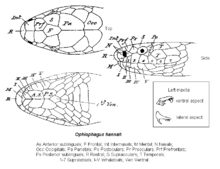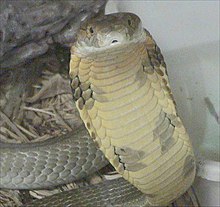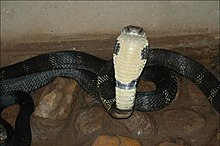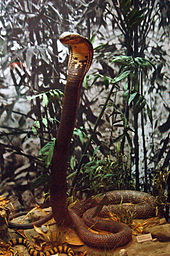
The king cobra (Ophiophagus hannah) is an elapid found predominantly in forests from India through Southeast Asia. This species is the world's longest venomous snake, with a length up to 18.5 to 18.8 ft (5.6 to 5.7 m). Despite the word "cobra" in its common name, this snake is not a member of the Naja genus ("true cobras"), which contains most cobra species, but the sole member of its own genus. It preys chiefly on other snakes and occasionally on some other vertebrates, such as lizards and rodents. The king cobra is a dangerous snake that has a fearsome reputation in its range, although it typically avoids confrontation with humans when possible. The king cobra is also culturally significant, with many legends and associations with Hindu gods around it in some Indiancultures.
Description
The king cobra averages at 3 to 4 m (9.8 to 13.1 ft) in length and typically weighs about 6 kg (13 lb). The longest known specimen was kept captive at the London Zoo, and grew to around 18.5 to 18.8 ft (5.6 to 5.7 m) before being euthanised upon the outbreak ofWorld War II. The heaviest wild specimen was caught at Royal Island Club in Singapore in 1951, which weighed 12 kg (26 lb) and measured 4.8 m (15.7 ft), though an even heavier captive specimen was kept at New York Zoological Park and was measured as 12.7 kg (28 lb) at 4.4 m (14.4 ft) long in 1972.[7] King cobras are sexually dimorphic in size, with males reaching larger sizes than females. The length and mass of the snakes highly depend on their localities and some other factors. Despite their large sizes, typical king cobras are fast and agile. Some viper species, such as the eastern diamondback rattlesnake and the Gaboon viper, often much shorter in length but bulkier in build, rival the king cobra in average weight and reportedly best them in maximum weight.
The skin of this snake is either olive-green, tan, or black, and it has faint, pale yellow cross bands down the length of the body. The belly is cream or pale yellow, and the scales are smooth. Juveniles are shiny black with narrow yellow bands (can be mistaken for a banded krait, but readily identified with its expandable hood). The head of a mature snake can be quite massive and bulky in appearance, though like all snakes, it can expand its jaws to swallow large prey items. It has proteroglyph dentition, meaning it has two short, fixed fangs in the front of the mouth, which channel venom into the prey like hypodermic needles. The average lifespan of a wild king cobra is about 20 years.
The dorsal scales along the centre of the king cobra's body have 15 rows. Males have 235 to 250 ventral scales, while females have 239 to 265. The subcaudal scales are single or paired in each row, numbering 83 to 96 in males and 77 to 98 in females.
Taxonomy
Ophiophagus hannah belongs to the monotypic genus Ophiophagus in the family Elapidae, while most other cobras are members of the genus Naja. They can be distinguished from other cobras by size and hood. King cobras are generally larger than other cobras, and the stripe on the neck is achevron instead of a double or single eye shape that may be seen in most of the other Asian cobras. Moreover, the hood of the king cobra is narrower and longer. A key to identification, clearly visible on the head, is the presence of a pair of large scales known as occipitals, located at the back of the top of the head. These are behind the usual "nine-plate" arrangement typical of colubrids and elapids, and are unique to the king cobra.
The species was first described by the Danish naturalist Theodore Edward Cantor in 1836.
Distribution and habitat
The king cobra is distributed across the Indian subcontinent, Southeast Asia, and the southern areas of East Asia (where it is not common), in Bangladesh, Bhutan, Burma, Cambodia, China, India, Indonesia, Laos, Nepal, the Philippines, Singapore, Thailand, and Vietnam. It lives in dense highland forests, preferring areas dotted with lakes and streams. King cobra populations have dropped in some areas of its range because of the destruction of forests and ongoing collection for the international pet trade. It is listed as an Appendix II animal within CITES.
Behavior
A king cobra, like other snakes, receives chemical information via its forked tongue, which picks up scent particles and transfers them to a special sensory receptor (Jacobson's organ) located in the roof of its mouth. This is akin to the human sense of smell. When the scent of a meal is detected, the snake flicks its tongue to gauge the prey's location (the twin forks of the tongue acting in stereo); it also uses its keen eyesight; king cobras are able to detect moving prey almost 100 m (330 ft) away. Its intelligence and sensitivity to earth-bornevibration are also used to track its prey.
Following envenomation, the king cobra likes to swallow its struggling prey while its toxins begin the digestion of its victim. King cobras, like all snakes, have flexible jaws. The jaw bones are connected by pliable ligaments, enabling the lower jaw bones to move independently. This allows the king cobra to swallow its prey whole, and swallow prey much larger than its head.
King cobras are able to hunt throughout the day, but are rarely seen at night, leading most herpetologists to classify them as a diurnalspecies.
Diet
The king cobra's generic name, Ophiophagus is a Greek-derived word which means "snake-eater", and its diet consists primarily of other snakes, including rat snakes, small pythons, and even other venomous snakes such as various members of the true cobras (of the genusNaja), and the krait. When food is scarce, they may also feed on other small vertebrates, such as lizards, birds, and rodents. In some cases, the cobra may "constrict" its prey, such as birds and larger rodents, using its muscular body, though this is uncommon. After a large meal, the snake may live for many months without another one because of its slow metabolic rate. The king cobra's most common meal is the rat snake; pursuit of this species often brings king cobras close to human settlements.
Defence
When confronted, this species quickly attempts to escape and avoid confrontation. However, if continuously provoked, the king cobra can be highly aggressive.
When concerned, it rears up the anterior portion (usually one-third) of its body when extending the neck, showing the fangs and hissing loudly. It can be easily irritated by closely approaching objects or sudden movements. When raising its body, the king cobra can still move forward to strike with a long distance and people may misjudge the safe zone. This snake may deliver multiple bites in a single attack, but adults are known to bite and hold on. It is secretive and tends to inhabit less-populated forested regions and dense jungle, thus many victims bitten by king cobras are actually snake charmers.
Some scientists believe that the temperament of this species has been grossly exaggerated. In most of the local encounters with live, wild king cobras, the snakes appear to be of rather placid disposition, and they usually end up being killed or subdued with hardly any hysterics. These support the view that wild king cobras generally have a mild temperament, and despite their frequent occurrence in disturbed and built-up areas, are adept at avoiding humans. Naturalist Michael Wilmer Forbes Tweedie felt that "this notion is based on the general tendency to dramatise all attributes of snakes with little regard for the truth about them. A moment’s reflection shows that this must be so, for the species is not uncommon, even in populated areas, and consciously or unconsciously, people must encounter king cobras quite frequently. If the snake were really habitually aggressive, records of its bite would be frequent; as it is they are extremely rare."
If a king cobra encounters a natural predator, such as the mongoose, which has resistance to the neurotoxins, the snake generally tries to flee. If unable to do so, it forms the distinctive cobra hood and emits a hiss, sometimes with feigned closed-mouth strikes. These efforts usually prove to be very effective, especially since it is much more dangerous than other mongoose prey, as well as being much too large for the small mammal to kill with ease.
A good defence against a cobra for anyone who accidentally encounters this snake is to slowly remove a shirt or hat and toss it to the ground while backing away.
Growling hiss
The hiss of the king cobra is a much lower pitch than many other snakes and many people thus liken its call to a "growl" rather than a hiss. While the hisses of most snakes are of a broad-frequency span ranging from roughly 3,000 to 13,000 Hz with a dominant frequency near 7,500 Hz, king cobra growls consist solely of frequencies below 2,500 Hz, with a dominant frequency near 600 Hz, a much lower-sounding frequency closer to that of a human voice. Comparative anatomical morphometric analysis has led to a discovery of tracheal diverticula that function as low-frequency resonating chambers in king cobra and its prey, the rat snake, both of which can make similar growls.
Reproduction
The king cobra is unusual among snakes in that the female is a very dedicated parent. She makes a nest for her eggs, scraping up leaves and other debris into a mound in which to deposit them, and remains in the nest until the young hatch. A female usually oviposits 20 to 40 eggs into the mound, which acts as an incubator. She stays with the eggs and guards the mound tenaciously, rearing up into a threat display if any large animal gets too close, for roughly 60 to 90 days.[21] Inside the mound, the eggs are incubated at a steady 28 °C (82 °F). When the eggs start to hatch, instinct causes the female to leave the nest and find prey to eat so she does not eat her young. The baby king cobras, with an average length of 45 to 55 cm (18 to 22 in), have venom which is as potent as that of the adults. They may be brightly marked, but these colours often fade as they mature. They are alert and nervous, being highly aggressive if disturbed.
Venom
The venom of the king cobra consists primarily of neurotoxins, known as the haditoxin, with several other compounds. Its murine LD50 toxicity varies from intravenous 1.31 mg/kg and intraperitoneal1.644 mg/kg to subcutaneous 1.7—1.93 mg/kg.
This species is capable of delivering a fatal bite and the victim may receive a large quantity of venom with a dose of 200 to 500 mg or even up to 7 ml. Engelmann and Obst (1981) list the average venom yield at 420 mg (dry weight). Accordingly, large quantities of antivenom may be needed to reverse the progression of symptoms developed if bitten by a king cobra. The toxins affect the victim's central nervous system, resulting in severe pain, blurred vision, vertigo, drowsiness, and eventually paralysis. If the envenomation is serious, it progresses to cardiovascular collapse, and the victim falls into a coma. Death soon follows due to respiratory failure. Moreover, envenomation from king cobras is clinically known to cause renal failure as observed from some snakebite precedents of this species though it is uncommon. Bites from a king cobra may result in a rapid fatality which can be as early as 30 minutes after the envenomation. The king cobra's envenomation was even recorded to be capable of killing elephants within hours.
Two types of antivenom are made specifically to treat king cobra envenomations. The Red Cross in Thailand manufactures one, and the Central Research Institute in India manufactures the other; however, both are made in small quantities and, while available to order, are not widely stocked. Ohanin, a protein component of the venom, causes hypolocomotion and hyperalgesia in mammals. Other components have cardiotoxic, cytotoxic and neurotoxic effects. In Thailand, a concoction of alcohol and the groundroot of turmeric is ingested, which has been clinically shown to create a strong resilience against the venom of the king cobra, and other snakes with neurotoxic venom. Proper and immediate treatments are critical to avoid death. Successful precedents include a client who recovered and was discharged in 10 days after being treated by accurate antivenom and inpatient care.
Snakebites from this species are rare and most victims are snake handlers. Not all king cobra bites result in envenomation, but are often considered of medical importance.Clinical mortality rates vary between different regions and depend on many factors, such as local medical advancement. A Thai survey reports 10 deaths out of 35 patients received for king cobra bites, whose fatality rate posed (28%) is higher than those of other cobra species. A six-year reviewing report published by South Indian Hospital revealed that two-thirds of the patients bitten by king cobras were graded "severe", though none died at the end due to proper medical treatments. Department of Clinical Toxinology in University of Adelaide gives this serpent a general untreated fatality rate of 50–60%, implying that the snake has about a half chance to deliver bites involving nonfatal quantities of venom.
Conservation
In India, king cobras are placed under Schedule II of Wildlife Protection Act, 1972 (as amended) and a person guilty of killing the snake can be imprisoned for up to 6 years.
Cultural significance
In Burma, king cobras are often used by female snake charmers. Members of the Pakkoku clan tattoo themselves with ink mixed with cobra venom on their upper bodies in a weekly inoculation which potentially might protect them from the snake, though no scientific evidence supports this. The charmer is usually tattooed with three pictograms.The charmer kisses the snake on the top of its head at the end of the show.
In the Indian subcontinent, the king cobra is believed to possess exceptional memory. According to a myth, the picture of the killer of a king cobra stays in the eyes of the snake, which is later picked up by the partner and is used to hunt down the killer for revenge. Because of this myth, whenever a cobra is killed, especially in India, the head is either crushed or burned to damage the eyes completely.







